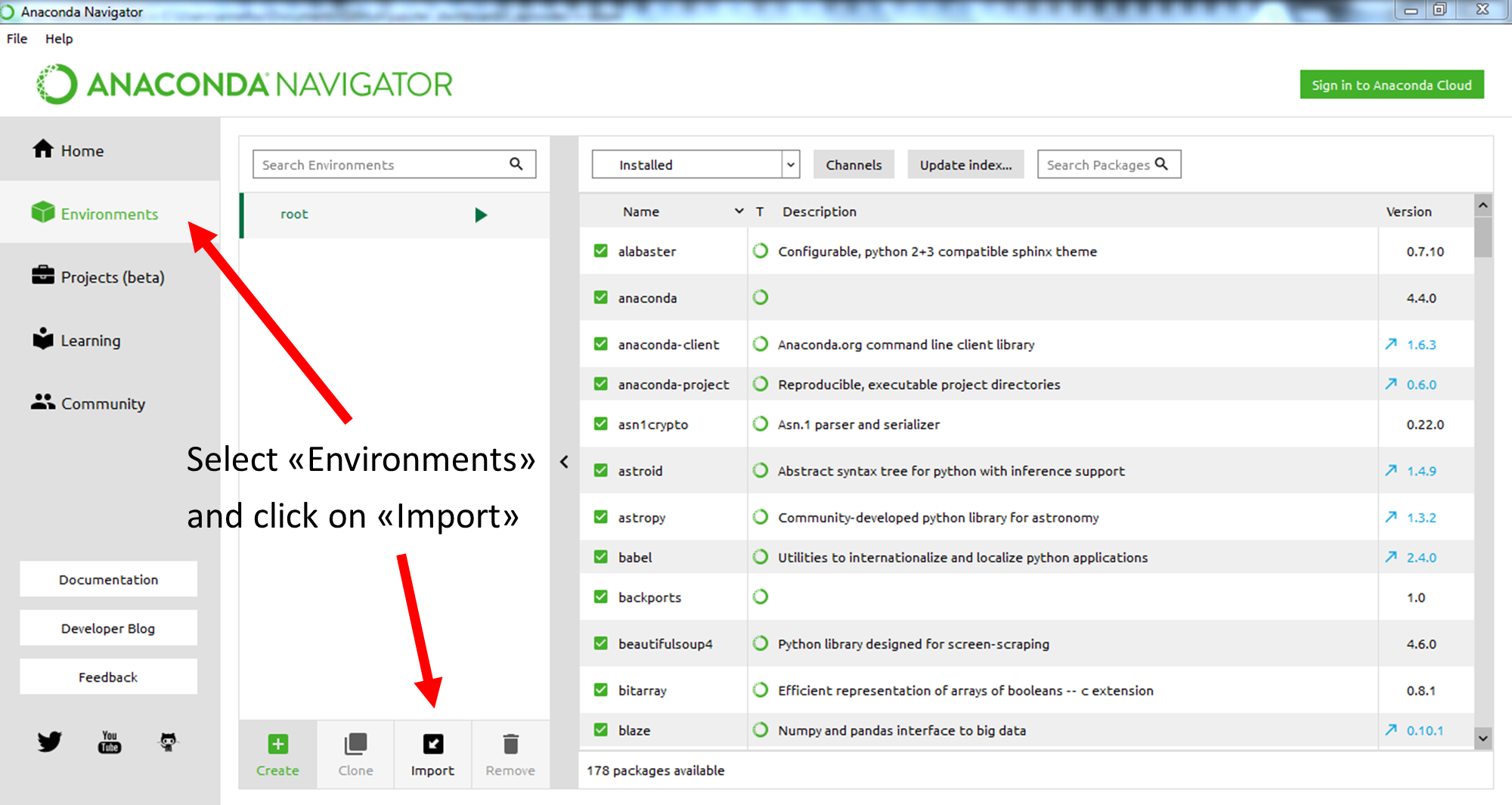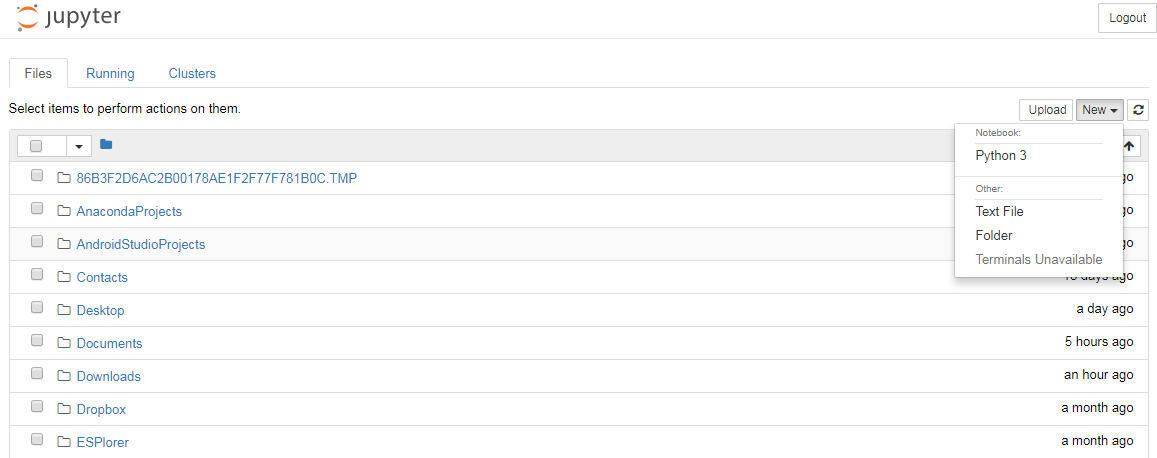Setup
To participate in the workshop, you will need access to the software described below. In addition, you will need an up-to-date web browser. You will need a PC with 64-bit CPU, since several packages we will be using are only available for 64-bit. To check this, open a bash shell, type
uname -m
If your system is 64-bit the answer should be `x86_64`.
We maintain a list of common issues that occur during installation as a reference for instructors that may be useful on the Configuration Problems and Solutions wiki page.
- Install the bash shell
- Install a Text editor
- Install Python Anaconda
- Install Anaconda Navigator
- Install Additional python packages for the workshop
The Bash Shell
Bash is a commonly-used shell that gives you the power to do simple tasks more quickly.
Windows
Video Tutorial- Download the Git for Windows installer.
- Run the installer and follow the steps below:
- Click on "Next" four times (two times if you've previously installed Git). You don't need to change anything in the Information, location, components, and start menu screens.
- Select “Use the nano editor by default” and click on “Next”.
- Keep "Use Git from the Windows Command Prompt" selected and click on "Next". If you forgot to do this programs that you need for the workshop will not work properly. If this happens rerun the installer and select the appropriate option.
- Click on "Next".
- Keep "Checkout Windows-style, commit Unix-style line endings" selected and click on "Next".
- Select "Use Windows' default console window" and click on "Next".
- Click on "Install".
- Click on "Finish".
-
If your "HOME" environment variable is not set (or you don't know what this is):
- Open command prompt (Open Start Menu then type
cmdand press [Enter]) -
Type the following line into the command prompt window exactly as shown:
setx HOME "%USERPROFILE%" - Press [Enter], you should see
SUCCESS: Specified value was saved. - Quit command prompt by typing
exitthen pressing [Enter]
- Open command prompt (Open Start Menu then type
This will provide you with both Git and Bash in the Git Bash program.
macOS
The default shell in all versions of macOS is Bash, so no
need to install anything. You access Bash from the Terminal
(found in
/Applications/Utilities).
See the Git installation video tutorial
for an example on how to open the Terminal.
You may want to keep
Terminal in your dock for this workshop.
Linux
The default shell is usually Bash, but if your
machine is set up differently you can run it by opening a
terminal and typing bash. There is no need to
install anything.
Text Editor
When you're writing code, it's nice to have a text editor that is optimized for writing code, with features like automatic color-coding of key words. The default text editor on macOS and Linux is usually set to Vim, which is not famous for being intuitive. If you accidentally find yourself stuck in it, hit the Esc key, followed by :+Q+! (colon, lower-case 'q', exclamation mark), then hitting Return to return to the shell.
Windows
nano is a basic editor and the default that instructors use in the workshop. It is installed along with Git.
Others editors that you can use are Notepad++ or Sublime Text. Be aware that you must add its installation directory to your system path. Please ask your instructor to help you do this.
macOS
nano is a basic editor and the default that instructors use in the workshop. See the Git installation video tutorial for an example on how to open nano. It should be pre-installed.
Others editors that you can use are BBEdit or Sublime Text.
Linux
nano is a basic editor and the default that instructors use in the workshop. It should be pre-installed.
Others editors that you can use are Gedit, Kate or Sublime Text.
Python
Python is a popular language for research computing, and great for general-purpose programming as well. Installing all of its research packages individually can be a bit difficult, so we recommend Anaconda, an all-in-one installer.
Regardless of how you choose to install it, please make sure you install Python version 3.x (e.g., 3.6 is fine).
We will teach Python using the Jupyter notebook, a programming environment that runs in a web browser. For this to work you will need a reasonably up-to-date browser. The current versions of the Chrome, Safari and Firefox browsers are all supported (some older browsers, including Internet Explorer version 9 and below, are not).
Windows
Video Tutorial- Open https://www.anaconda.com/download/#windows with your web browser.
- Download the Python 3 installer for Windows.
- Install Python 3 using all of the defaults for installation except make sure to check Add Anaconda to my PATH environment variable.
macOS
Video Tutorial- Open https://www.anaconda.com/download/#macos with your web browser.
- Download the Python 3 installer for OS X.
- Install Python 3 using all of the defaults for installation.
Linux
- Open https://www.anaconda.com/download/#linux with your web browser.
- Download the Python 3 installer for Linux.
(The installation requires using the shell. If you aren't comfortable doing the installation yourself stop here and request help at the workshop.) - Open a terminal window.
-
Type
bash Anaconda3-
and then press Tab. The name of the file you just downloaded should appear. If it does not, navigate to the folder where you downloaded the file, for example with:cd Downloads
Then, try again. -
Press Return. You will follow the text-only prompts. To move through
the text, press Spacebar. Type
yesand press enter to approve the license. Press enter to approve the default location for the files. Typeyesand press enter to prepend Anaconda to yourPATH(this makes the Anaconda distribution the default Python). - Close the terminal window.
Anaconda Navigator
One of the useful things about Anaconda Python is its tools for Python package management and project environments. The core tool for this is the command-line utility conda. However, there is also a GUI tool called “Anaconda Navigator”.
As part of this workshop, we will learn how to use Anaconda navigator to manage our Python environment and for this setup section, you only need to check Anaconda Navigator is available on your laptop. Do not hesitate to contact us if you have any problems. We will be able to help you with the installation during the workshop so do not worry!
Test your Installation
Launch “Anaconda Navigator” from your menu. This should work on any operating system (Windows, Mac-OSX and Linux) and a window should pop up:

On Mac-OSX or Linux, you may want to launch it from the command line:
$ anaconda-navigator
Credits
This installation tutorial is taken from Software Carpentry
Additional python packages for the workshop
We will be using Anaconda Navigator to install all the python packages we will be using for this lesson.
Download deep_environment.yml to your local computer
- Right click on the following link deep_environment.yml and “save as link” it to your local computer
- Make sure you know where you saved it! (Check your “Downloads” folder).
Start Anaconda navigator
WINDOWS
After you install Anaconda on Windows, start Navigator by:
Clicking the Anaconda Navigator desktop app from the start menu. Or by opening an Anaconda Prompt from the start menu and running the command anaconda-navigator.
MacOS
After you install Anaconda on macOS, start Navigator by:
Clicking the Navigator menu item that was automatically added to your menu.
Or open Launchpad, click Terminal or iTerm and enter the command anaconda-navigator.
$ anaconda-navigator
Linux
After you install Anaconda on Linux, you can start Anaconda Navigator by opening a Terminal window and running the command “anaconda-navigator”:
$ anaconda-navigator
Anaconda does not add shortcuts for Linux automatically because different Linux distributions have different systems for adding menu or desktop shortcuts. You can use your operating system to create desktop and/or main-menu shortcuts that run the command anaconda-navigator.

For more information on how to start Anaconda Navigator look here.
Create a new conda environment “deeplearning”
From the command line (Mac OSX and Linux)
Open a Terminal and type:
conda env create -f deep_environment.yml
source activate deep_python
jupyter notebook
From Anaconda Navigator
- Click on tab “Environments” (menu on the left hand side) and then “Import”

-
Click on the “Folder” icon and browse your file to select deep_environment.yml.

-
Click on “Import”. This stage may take a few minutes so be patient…
Start jupyter notebook
We want to start a new jupyter notebook using our newly created conda environment. To select “deeplearning” conda environment:
- Click on “Home” (left menu)
- Select “deeplearning” in “Applications on”
- Launch jupyter notebook (“Launch” button)
Jupyter starts in your default browser at the address http://localhost:8888/tree and shows the tree (directories) from the root directory (here is root directory is to be understood from the installation location of Anaconda). It may vary from one laptop to another but you should not worry about it.
When clicking on “New” (right hand side) as shown on the Figure below:

You should be able to select “Python 3”. That’s all you need for the workshop!
Default browser
You may need to change the default browser for starting your jupyter notebook. All the examples in this lesson have been tested with Google chrome